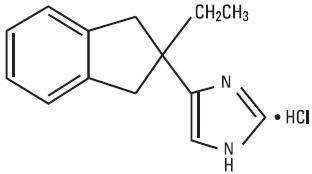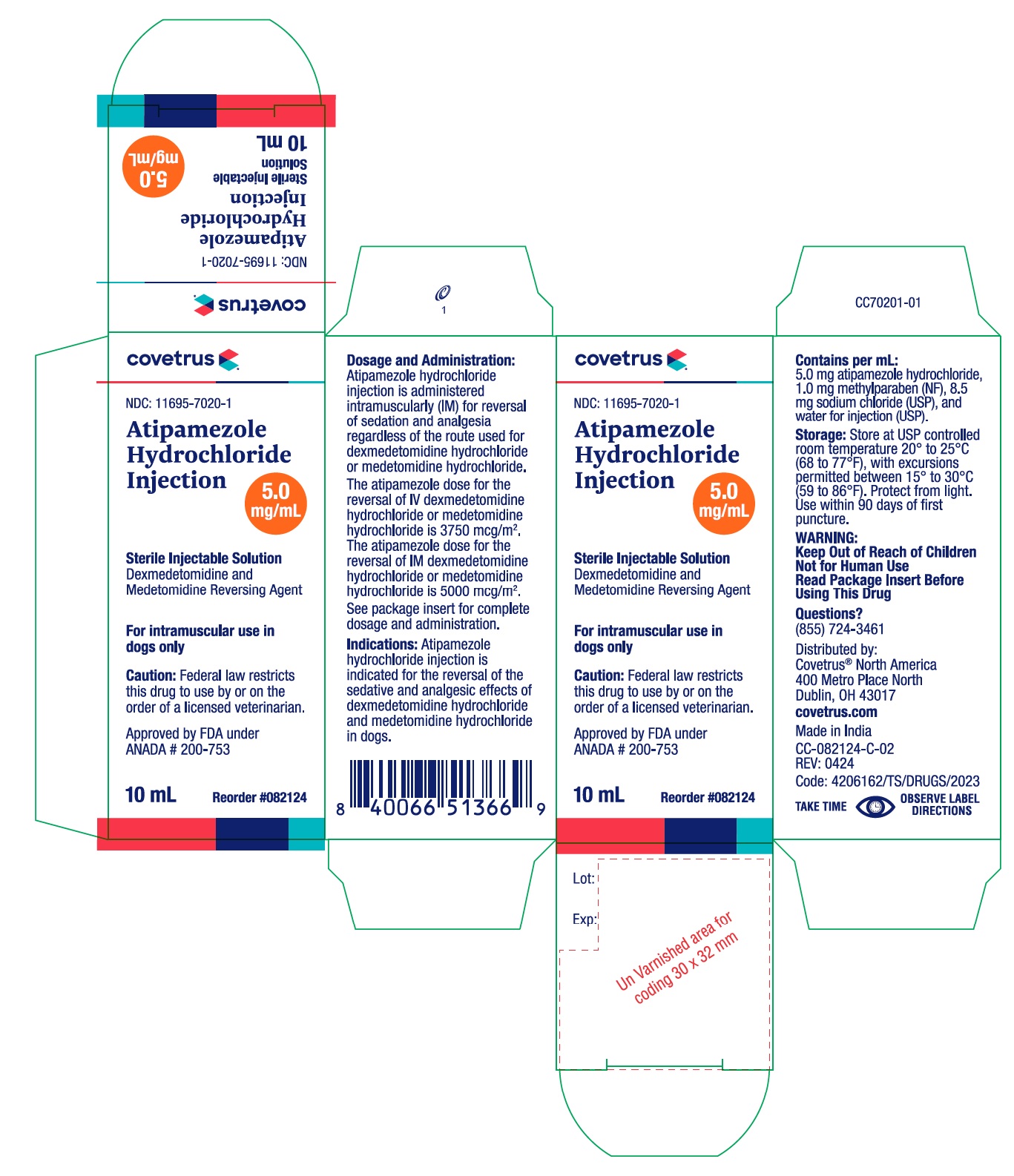ATIPAMEZOLE HYDROCHLORIDE injection, solution
atipamezole hydrochloride by
Drug Labeling and Warnings
atipamezole hydrochloride by is a Animal medication manufactured, distributed, or labeled by BUTLER ANIMAL HEALTH SUPPLY, LLC DBA COVETRUS NORTH AMERICA. Drug facts, warnings, and ingredients follow.
Drug Details [pdf]
- SPL UNCLASSIFIED SECTION
- CAUTION
-
DESCRIPTION
Atipamezole hydrochloride is a synthetic α2-adrenergic antagonist.
The chemical name is 4-(2-ethyl-2,3-dihydro-1H-inden-2-yl)-1H-imidazole hydrochloride.
The molecular formula is C14H16N2 HCl and structural formula is:
Each mL of Atipamezole hydrochloride injection contains 5.0 mg atipamezole hydrochloride, 1.0 mg methylparaben (NF), 8.5 mg sodium chloride (USP), and water for injection (USP).
- INDICATIONS
-
DOSAGE AND ADMINISTRATION
Atipamezole hydrochloride injection is administered intramuscularly (IM) for reversal of sedation and analgesia regardless of the route used for dexmedetomidine hydrochloride or medetomidine hydrochloride. The atipamezole dose for the reversal of IV dexmedetomidine hydrochloride or medetomidine hydrochloride is 3750 mcg/m2. The atipamezole dose for the reversal of IM dexmedetomidine hydrochloride or medetomidine hydrochloride is 5000 mcg/m2.
The dosage of Atipamezole hydrochloride injection is calculated based on body surface area. Use the following tables to determine the correct injection volume or the correct Atipamezole hydrochloride injection dosage on the basis of kilograms of body weight.
Note that the mcg/kg dosage decreases as body weight increases.
Table 1: Atipamezole dosing for reversal of IV dexmedetomidine- or medetomidine-induced sedation/analgesia:
Dose table for Atipamezole hydrochloride injection (3750 mcg/m2) when dexmedetomidine or medetomidine is given IV For # lbs For # kg dose = mcg/kg Volume = mL Atipamezole hydrochloride 4-7 2-3 300 0.1 7-9 3-4 250 0.15 9-11 4-5 230 0.2 11-22 5-10 200 0.3 22-33 10-15 170 0.4 33-44 15-20 150 0.5 44-55 20-25 140 0.6 55-66 25-30 130 0.7 66-81 30-37 120 0.8 81-99 37-45 110 0.9 99-110 45-50 105 1.0 110-132 50-60 100 1.1 132-143 60-65 95 1.2 143-165 65-75 93 1.3 165-176 75-80 91 1.4 >176 >80 90 1.5 Table 2: Atipamezole dosing for reversal of IM dexmedetomidine- or medetomidine-induced sedation/analgesia:
Dose table for Atipamezole hydrochloride injection (5000 mcg/m2) when dexmedetomidine or medetomidine is given IM For # lbs For # kg dose = mcg/kg Volume = mL Atipamezole hydrochloride 4-7 2-3 400 0.15 7-9 3-4 350 0.2 9-11 4-5 300 0.3 11-22 5-10 250 0.4 22-29 10-13 230 0.5 29-33 13-15 210 0.6 33-44 15-20 200 0.7 44-55 20-25 180 0.8 55-66 25-30 170 0.9 66-73 30-33 160 1.0 73-81 33-37 150 1.1 81-99 37-45 145 1.2 99-110 45-50 140 1.3 110-121 50-55 135 1.4 121-132 55-60 130 1.5 132-143 60-65 128 1.6 143-154 65-70 125 1.7 154-176 70-80 123 1.8 >176 >80 120 1.9 -
CONTRAINDICATIONS
Since atipamezole is always used concomitantly with dexmedetomidine or medetomidine, it should not be used in dogs with the following conditions: cardiac disease, respiratory disorders, liver or kidney diseases, dogs in shock, severely debilitated dogs, or dogs stressed due to extreme heat, cold or fatigue.
Administration of atipamezole is contraindicated in dogs with a known hypersensitivity to the drug.
-
HUMAN WARNINGS
Not for human use. Keep out of reach of children.
Atipamezole hydrochloride can be absorbed and may cause irritation following direct exposure to skin, eyes, or mouth. In case of accidental eye exposure, flush with water for 15 minutes. In case of accidental skin exposure, wash with soap and water. Remove contaminated clothing.
If irritation or other adverse reaction occurs (for example, increased heart rate, tremor, muscle cramps), seek medical attention.
In case of accidental oral exposure or injection, seek medical attention. Caution should be used while handling and using filled syringes.
Users with cardiovascular disease (for example, hypertension or ischemic heart disease) should take special precautions to avoid any exposure to this product.
Note to Physician: This product contains an alpha2-adrenergic antagonist.
-
PRECAUTIONS
1. Handling
Atipamezole hydrochloride injection can produce an abrupt reversal of sedation; therefore, dogs that have recently received an Atipamezole hydrochloride injection should be handled with caution. The potential for apprehensive or aggressive behavior should be considered in the handling of dogs emerging from sedation, especially in dogs predisposed to nervousness or fright. Also, avoid situations where a dog might fall.2. Sedation relapse
While atipamezole does reverse the clinical signs associated with medetomidine or dexmedetomidine sedation, complete physiologic return to pretreatment status may not be immediate or may be temporary, and dogs should be monitored for sedation relapse. Sedation relapse is more likely to occur in dogs that receive an alpha2-agonist by the IV route, compared to dogs that are sedated using the IM route. Animals should be monitored closely for persistent hypothermia, bradycardia, and depressed respiration, until signs of recovery persist.3. Analgesia reversal
Atipamezole reverses analgesic effects as well as sedative effects. Additional procedures for the control of pain may be required.4. Debilitated dogs
The safety of atipamezole has not been evaluated in dogs with compromised health. Geriatric, debilitated, and ill dogs are more likely to experience adverse reactions associated with the administration of alpha2-antagonists (as well as alpha2-agonists). Dogs with abnormalities associated with the cardiovascular system are especially at risk.5. Breeding dogs
Atipamezole hydrochloride injection has not been evaluated in breeding dogs; therefore, the drug is not recommended for use in pregnant or lactating dogs, or in dogs intended for breeding.6. Minimum age and weight
Atipamezole hydrochloride injection has not been evaluated in dogs less than four months of age or in dogs weighing less than 4.4 lbs (2 kg). -
ADVERSE REACTIONS
Occasional vomiting may occur. At times, a period of excitement or apprehensiveness may be seen in dogs treated with atipamezole. Other effects of atipamezole include hypersalivation, diarrhea, and tremors.
To report suspected adverse drug events, for technical assistance or to obtain a copy of the Safety Data Sheet, contact Covetrus® North America at 855-724-3461 or covetrus.com. For additional information about adverse drug experience reporting for animal drugs, contact FDA at 1-888-FDA-VETS or http://www.fda.gov/reportanimalae.
-
CLINICAL PHARMACOLOGY
Atipamezole is a potent alpha2-antagonist which selectively and competitively inhibits alpha2-adrenergic receptors. The result of atipamezole administration in the dog is the rapid recovery from the sedative and analgesic effects produced by the alpha2-adrenergic agonists dexmedetomidine or medetomidine. Atipamezole does not reverse the effects of other classes of sedatives, anesthetics, or analgesics.
Atipamezole is rapidly absorbed following intramuscular injection; maximum serum concentration is reached in approximately 10 minutes. Onset of arousal is usually apparent within 5 to 10 minutes of injection, depending on the depth and duration of dexmedetomidine- or medetomidine-induced sedation. Elimination half-life from serum is less than 3 hours. Atipamezole undergoes extensive hepatic biotransformation, with excretion of metabolites primarily in urine.
Dexmedetomidine or medetomidine activation of peripheral and central alpha2-adrenergic receptors induces a pattern of pharmacological responses that include sedation, reduction of anxiety, analgesia, and bradycardia.
Blood pressure is initially increased due to peripheral vasoconstriction and thereafter drops to normal or slightly below normal levels. A transient, decrease in systolic blood pressure occurs immediately after administration of atipamezole to dexmedetomidine- or medetomidine-sedated dogs, followed by a transient increase in arterial pressure within 10 minutes compared to pre-atipamezole levels. This is the opposite of the response to alpha2-agonist treatment, and is probably due to atipamezole-induced peripheral vasodilation.
Atipamezole administration rapidly abolishes dexmedetomidine- or medetomidine-induced bradycardia, usually within 3 minutes. The magnitude of the effect of atipamezole on heart rate is greater when dexmedetomidine is administered intravenously compared to intramuscularly. Dogs receiving medetomidine or IM dexmedetomidine may not return to pre-sedative heart rates after atipamezole administration and some dogs briefly show heart rate elevations above baseline. Respiratory rate increases following atipamezole injection.
-
EFFECTIVENESS
One hundred and nine dogs received atipamezole in the field study (55 dogs received the reversal agent following dexmedetomidine; 54 following medetomidine). The mean age was 5.9 years and ranged between 17 weeks and 16 years. The mean weight was 45.5 lbs (20.7 kg), ranging from 4.8 lbs to 117 lbs (2.2 kg to 53.2 kg). Atipamezole was administered by the IM route of administration, within a range of 39-57 minutes after administration of either dexmedetomidine (IV and IM) or medetomidine (IV and IM).
Atipamezole reversed the effects of dexmedetomidine and medetomidine in all cases. In dexmedetomidine treated dogs, the onset of reversal was evident within 5 minutes after administration of atipamezole (57% could stand). Within 15 minutes, 96% of dexmedetomidine treated dogs were standing, 92% responded normally to sound, 86% had a normal muscle tone of jaw, and >90% had a normal pedal reflex response. Responses in dogs treated with medetomidine were similar or slightly later.
Following atipamezole, heart rate increased between 0 and 5 minutes following either alpha2-agonist (IV dexmedetomidine dogs had heart rates from 60 to 85 bpm, and IV medetomidine dogs from 51 to 67 bpm; IM dexmedetomidine dogs had heart rates from 45 to 73 bpm, and IM medetomidine dogs from 52 to 79 bpm). Bradycardia resolved more slowly in the IM treatment groups. The body temperature remained at the same level during the 120 minutes of follow-up after atipamezole administration. Respiratory rates increased toward normal between 0 and 5 minutes after the administration of atipamezole in all treatment groups. Mucous membranes were described as normal after 5 minutes in 91% of dexmedetomidine dogs (IV or IM). By 120 minutes, 96% were normal (after IV dexmedetomidine) or 100% were normal (after IM dexmedetomidine). Many physiological responses were slightly slower to return toward normal when dogs were treated with medetomidine IV or IM.
No adverse events were reported in the atipamezole treated dogs.
-
ANIMAL SAFETY
Atipamezole was tolerated in healthy dogs receiving 10X the recommended dose and in dogs receiving repeated doses at 1, 3, and 5X the recommended dose, in the absence of an alpha2-agonist. Signs were dose-related and included excitement, panting, trembling, vomiting, soft or liquid feces and scleral injection. At 10X the recommended dose, increases in creatine kinase, AST, and ALT were noted. Creatine kinase also increased in 3 (of 6) dogs in the 3X treatment group. Localized skeletal muscle injury was seen at the injection site but no associated clinical signs or complications were observed. Dogs receiving the recommended atipamezole dose in the absence of medetomidine or dexmedetomidine exhibited no adverse clinical signs. In additional safety studies, adverse events were absent up to the 3X dose of atipamezole when its administration followed medetomidine or dexmedetomidine sedation.
In a separate safety study using a crossover design, 5 dogs received atipamezole after dexmedetomidine (IV and IM). Dexmedetomidine’s effects on blood pressure, heart rate, respiratory rate, and cardiac conduction times were reversed by atipamezole. However, heart rate and cardiac conduction times did not return to predexmedetomidine values. Heart rate increases after atipamezole were closer to baseline values in dogs treated with dexmedetomidine IV (compared to IM).
- STORAGE INFORMATION
-
HOW SUPPLIED
Atipamezole hydrochloride injection is supplied in 10-mL, multidose vials containing 5.0 mg of atipamezole hydrochloride per mL.
Approved by FDA under ANADA # 200-753

Questions?
(855) 724-3461
Distributed by:
Covetrus® North America
400 Metro Place North
Dublin, OH 43017
covetrus.com
Reorder #082124
Made in India
CC-AtipamezolePI-02
REV: 0424
© 2023 Covetrus, Inc. All rights reserved. No copying without consent.
-
PACKAGE LABEL.PRINCIPAL DISPLAY PANEL
NDC: 11695-7020-01
Atipamezole hydrochloride injection
5.0 mg/mL
Sterile Injectable Solution
Dexmedetomidine and Medetomidine Reversing Agent
For intramuscular use in dogs only
Caution: Federal law restricts this drug to use by or on the order of a licensed veterinarian.
Approved by FDA under ANADA # 200-753
10 mL Reorder #082124

-
INGREDIENTS AND APPEARANCE
ATIPAMEZOLE HYDROCHLORIDE
atipamezole hydrochloride injection, solutionProduct Information Product Type PRESCRIPTION ANIMAL DRUG Item Code (Source) NDC: 11695-7020 Route of Administration INTRAMUSCULAR Active Ingredient/Active Moiety Ingredient Name Basis of Strength Strength ATIPAMEZOLE HYDROCHLORIDE (UNII: 2W4279571X) (ATIPAMEZOLE - UNII:03N9U5JAF6) ATIPAMEZOLE HYDROCHLORIDE 5 mg in 1 mL Packaging # Item Code Package Description Marketing Start Date Marketing End Date 1 NDC: 11695-7020-1 10 mL in 1 VIAL, GLASS Marketing Information Marketing Category Application Number or Monograph Citation Marketing Start Date Marketing End Date ANADA ANADA200753 10/01/2023 Labeler - BUTLER ANIMAL HEALTH SUPPLY, LLC DBA COVETRUS NORTH AMERICA (603750329)
© 2025 FDA.report
This site is not affiliated with or endorsed by the FDA.